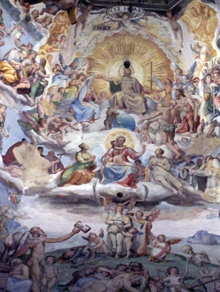In 1561, Agostino Lapini, a singer in the cathedral of Florence, records the performance of a most unusual song composed in honour of two visiting papal envoys. Unusual, because unlike most new songs, or motets, which were written in anything between four and eight parts, this one was in no fewer than forty separate independent parts, and its composer was the composer-diplomat Alessandro Striggio. It is thought that the performance may have been part of an elaborate sacra scena, featuring masked and costumed singers descending on cloud machines in a literal representation of one of those scenes familiar from the ceilings of a thousand Baroque churches: rank upon rank of angels wielding harps,cornetts, shawns, dulcimers and violins among the company of Heaven.
With Striggio’s motet Ecce beatam lucem, and the Mass Ecco sì beato giorno which he finished by 1566, begins the history of the Renaissance musical blockbuster, a genre designed to glorify the power and majesty of the era’s greatest princes, be it the Medici court to which Striggio was attached, or the Doges of Venice in the later polychoral works of Giovanni Gabrieli. In Striggio’s hands, forty-part music is first and foremost musical shock-and-awe, and he wasted little time in taking it wherever he or his master wished to amaze and impress: to Munich, where it was performed under Lassus’ direction at Albrecht V’s court; to Paris, to Brno, where it was presented to the Holy Roman Emperor Maximilian, and most famously to Elizabeth’s court in England.
In England as elsewhere, this magnificent music, featuring eight choirs of five voices (or instruments) each and skilfully employing novel effects of spatialisation, evidently caused a sensation – as well as piquing a certain strain of chauvinistic competitiveness. According to an account written some forty years later, the Duke of Norfolk, upon hearing Striggio’s piece, ‘asked whether none of our Englishmen could sette as good a songe, & Tallice beinge very skillfull was felt to try whether he could undertake the Matter…’ Thomas Tallis’ Spem in alium, the result of this throwing-down of the national gauntlet, is rightly considered the apogee of Renaissance forty-part music. Unlike Striggio, who goes for bold juxtapositions, block-chord textures and a rather basic (though mightily effective) harmonic palette, Tallis manages to create a more subtle and ambiguous work, a true masterpiece, weaving polyphonic textures of great complexity first one way and then another around the performance space and deploying the full forces sparingly and with great dramatic timing. To understand Tallis’ and Striggio’s works one must hear these pieces in situ, where the movement of the music in space as it is passed from one choir to another creates a whole new dimension to the sonic experience, and must truly have seemed to contemporaries like a glimpse of celestial harmony.
It would be wrong, however, to imagine that these forty-part pieces, whose gigantic conception was not again to be matched until the modern era, sprang from nowhere into an unsuspecting musical world. In many ways they are to be seen as a natural, if unsustainable, development in Renaissance musical (and, crucially, political) aesthetics. Their origins lie in musical precedents such as Brumel’s Mass Et ecce terrae motus, the so-called Earthquake Mass, of 1500, a work whose twelve parts provides scarcely less impact than either Striggio’s or Tallis’ forty. Around the same time there are example of canons in twenty-four and thirty-six parts, attributed to Josquin and Ockeghem respectively, and there is a motet, O bone Jesu, by the Scottish composer Robert Carver, for nineteen voices. Polychoral music, for spatialised choirs, usually in eight but sometimes in twelve or more, became a house style in St Mark’s Venice in the time of Willaert in the 1540s and 50s, and by the 1560s was practised across musical Europe in works by Lassus, Andrea Gabrieli and many others.
It seems fair, then, to contextualise Striggio’s and Tallis’ pieces as merely the latest and grandest in a series of periodic outbreaks of musical giganticism, both of them essentially pièces d’occasion to impress a dignitary, or to bolster the national musical ego. Even the most sumptuous courts could not afford spectacles like these on a day-to-day basis, and it was only for royal weddings, coronations and the lavish ceremonial occasions connected with power politics that the forces were mustered to perform them. What is more interesting, perhaps, is what links all of these pieces: the attempt to depict a sense of majesty, of teeming grandeur and limitless splendour, both temporal and celestial. Brumel’s is a Mass of the Resurrection, and by extension of the Last Judgement; the Venetians, both before and after Tallis and Striggio, gazed on a golden city of unparalleled wealth; Striggio’s motet is a vision of the New Jerusalem:
Nourishing strength and majesty is to be seen everywhere
How radiant is the sun’s beauty,
how lovely the moon,
how gloriously the stars shine,
how beautiful are all the things in the world
And Tallis too, though the rather penitential text seems at first oddly chosen for such a piece, ends with a prayer to the ‘Lord God, Creator of Heaven and Earth’ to look upon the lowliness of man. Even with our heads bowed in prayer, we feel the distance from the ground to the stars.
Forty-part music (the number forty being, of course, Biblical shorthand for ‘a large number’) presents us with a grandeur that does not merely display itself but encompasses and penetrates, surrounding the listener in a way that seems to connect us deeply to everything around. It is the representation in music of the infinite, of grains of sand and numbers of stars. The difference in sound between twelve and forty voices is not one of technical musical complexity, even in Tallis’ hands, but of this sense of teeming multitudes, of numbers too great to count.
Apposite, then, that it should be this special musical texture that Michael Zev Gordon has chosen for his hymn to the Genome. The continuity between the Renaissance vision of a limitless Heaven and a modern sense of awe at the wonder of Nature resounds unbroken, from Striggio and Tallis to the fervent rapture of Allele.
James Weeks
![]()



